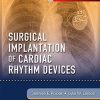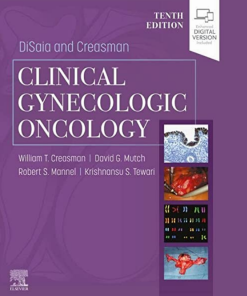(Ebook PDF) Principles of Gynecologic Oncology Surgery 1st Edition by Pedro Ramirez, Michael Frumovitz, Nadeem Abu Rustum ISBN 9780323442787 0323442781 full chapters
$50.00 Original price was: $50.00.$25.00Current price is: $25.00.
(Ebook PDF) Principles of Gynecologic Oncology Surgery 1st Edition by Pedro Ramirez, Michael Frumovitz, Nadeem Abu Rustum –Ebook PDF Instant Download/Delivery: 9780323442787, 0323442781
Instant download Full Chapter of Principles of Gynecologic Oncology Surgery 1st Edition after payment

Product details:
ISBN 10: 0323442781
ISBN 13: 9780323442787
Author: Pedro T Ramirez; Michael Frumovitz; Nadeem R Abu-Rustum
With an emphasis on a practical, “how-to” approach, this comprehensive text addresses the most important and commonly performed procedures in gynecologic oncology surgery today. Written by leaders in the field, Principles of Gynecologic Oncology Surgery clearly describes the critical steps for each procedure, provides up-to-date information on the recent literature, and includes high-quality illustrations of anatomy and technique.
Table of contents:
Section 1. Anatomy and Principles of Surgery
- Chapter 1. Introduction to Principles of Gynecologic Oncology Surgery
- Chapter 2. Abdominal and Pelvic Anatomy
- Pelvic Anatomy
- The Retroperitoneum
- Anatomy of the Upper Abdomen and Midabdomen
- Conclusion
- Chapter 3. Enhanced Recovery After Surgery in Gynecologic Oncology Surgery
- ERAS in Gynecologic Oncology
- Elements of ERAS Program and Guidelines
- Summary
Section 2. Vulvar Cancer
- Chapter 4. Vulvar Surgery and Sentinel Node Mapping for Vulvar Cancer
- Presentation, Diagnosis, and Workup
- Preoperative Considerations
- Sentinel Nodes in Vulvar Cancer
- Surgical Procedures
- Complications and Morbidity
Section 3. Cervical Cancer
- Chapter 5. Conservative Surgery in Early-Stage Cervical Cancer
- Radical Trachelectomy
- Surgical Techniques
- Key Points
- Chapter 6. The Application of Sentinel Lymph Node Biopsy in Cervical Cancer
- Lymph Node Involvement in Cervical Cancer
- Cervical Cancer: A Candidate for Sentinel Lymph Node Mapping
- Anatomy of the Cervix and Its Lymphatic Channels
- Efficiency of Sentinel Lymph Node Technique
- Methodologies
- The Performance of the Detection Modalities
- Pathology Processing: Ultrastaging Immunohistochemistry and Polymerase Chain Reaction
- Morbidity
- Typical and Unexpected Locations of Sentinel Lymph Nodes
- Limitations of Sentinel Lymph Node Technique
- Indications for Sentinel Lymph Node Detection
- Impact of Neoadjuvant Chemotherapy on Sentinel Lymph Node Detection
- Technical Application and Suggested Algorithm
- Conclusion
- Chapter 7. Abdominal Radical Hysterectomy
- History of Radical Hysterectomy
- Indications for Radical Hysterectomy
- Preoperative Evaluation
- Surgical Approach
- Surgical Assessment and Technique
- Step-by-Step Approach to Abdominal Radical Hysterectomy
- Complications of Radical Hysterectomy
- Summary
- Key Points
- Chapter 8. Surgical Staging for Treatment Planning
- Anatomic Considerations
- General Instrumentation
- Extraperitoneal Laparoscopic Paraaortic Node Dissection
- Technical Difficulties
- Anatomic Variations
- Potential Limitations
- Alternative Approaches
- Other Considerations
Section 4. Endometrial Cancer
- Chapter 9. Hysterectomy With Pelvic and Paraaortic Lymphadenectomy
- Role of Lymphadenectomy
- Role of Oophorectomy at the Time of Hysterectomy
- Preoperative Evaluation
- Perioperative Management
- Surgical Technique
- Summary
- Key Points
- Chapter 10. Sentinel Lymph Node Mapping for Endometrial Cancer
- Importance of Lymph Node Assessment
- Sentinel Lymph Node Mapping Techniques
- Colored Dye Injection
- Sentinel Lymph Node Mapping Algorithm
- Sentinel Lymph Node Ultrastaging
- Summary
Section 5. Ovarian Cancer
- Chapter 11. Indications for Laparoscopic Assessment of Cytoreduction
- Background
- Imaging Tools for Preoperative Evaluation
- Summary
- Chapter 12. Radical Upper Abdominal Surgery: Liver, Diaphragm, and Spleen
- Anatomic Considerations
- Adjacent Organs at Risk: Stomach, Duodenum, Right Kidney, and Right Adrenal Gland
- Cytoreductive Surgery
- Cytoreduction of Diaphragmatic Disease
- Spleen
- Conclusion
- Chapter 13. Radical Pelvic and Retroperitoneal Ovarian Cancer Surgery
- Pelvis
- Retroperitoneum
- Retroperitoneal Node Dissection
- Pelvic Lymphadenectomy: Surgical Technique
- Aortic Node Dissection
- Transperitoneal Technique by Laparotomy
- Pelvic Surgery for Advanced Ovarian Cancer: Surgical Technique
- Chapter 14. Complications and Management of Radical Cytoreduction
- Complication Classification Systems
- Preoperative Risk Assessment for Complications
- Preoperative Care Planning and Prevention of Complications
- Postoperative Care Planning
- Perioperative Complications
- Hemorrhage
- Infection
- Gastrointestinal Tract Complications
- Ascites Reaccumulation and Abdominal Compartment Syndrome
- Hematologic Disorders
- Thromboembolic Complications
- Respiratory Complications
- Cardiac and Neurovascular Complications
- Renal Failure
- Complications of Intraoperative Hyperthermic Intraperitoneal Chemotherapy
- Mortality
- Conclusion
Section 6. Pelvic Exenteration
- Chapter 15. Pelvic Exenteration for Gynecologic Cancers
- History
- Indications
- Classification
- Preoperative Imaging
- Prognostic Factors and Contraindications
- Oncologic Outcomes
- Combined Treatment
- Counseling
- Chapter 16. Complications of Pelvic Exenteration
- Medical Complications
Section 7. Surgery on the Intestinal Tract
- Chapter 17. Small Bowel and Large Bowel Resection and Anastomosis
- Regional Vascular Anatomy of the Small Bowel and Large Bowel
- Anatomy of the Small Intestine
- Anatomy of the Large Intestine
- Surgical Techniques
- Chapter 18. Management of Bowel Surgery Complications
- Special Anatomy
- Iatrogenic Injuries During Minimally Invasive Surgery
- Deep Space Surgical Site Infections
- Anastomotic Complications
- Enterocutaneous Fistulas
- Blind Loop Syndrome and Intestinal Bacterial Overgrowth
- Postsurgical Nutritional Deficiencies and Short Gut Syndrome
- Obstructions
Section 8. Surgery on the Urinary Tract
- Chapter 19. Management of Urologic Complications in Gynecologic Oncology Surgery
- Ureteral Injuries and Management
- Conclusion
Section 9. Pelvic Reconstructive Procedures
- Chapter 20. Pelvic Reconstruction in Gynecologic Oncology Surgery
- Indications
- Procedures
- Regional Flaps: Abdomen
- Regional Flaps: Thigh and Buttock
- Conclusion
- Chapter 21. Urinary Diversion in Gynecologic Oncology
- Historical Perspective of Urinary Diversions
- Indications for Urinary Diversion
- Preoperative Management
- Surgical Techniques for Urinary Diversion
- Minimally Invasive Approach to Urinary Diversion
- Postoperative Care and Management of Postoperative Complications
- Management of Postoperative Complications
- Quality of Life
- Key Points
- Chapter 22. Management of Vascular Complications
- Vascular Anatomy in Gynecologic Oncology Surgery
- Gynecologic Malignancy Involving Major Vessels
- Acute Major Intraoperative Vascular Injuries
- Surgical Techniques for Major Vascular Reconstruction
- Postoperative Care and Surveillance
- Other Major Vascular Complications
- Summary
- Chapter 23. Complications of Radiation Oncology
- Radiation Oncology
- Fractures
- Necrosis
- Rectal Proctitis
- Urologic Complications
- Conclusion
Section 10. Minimally Invasive Surgery
- Chapter 24. Laparoendoscopic Single-Site Surgery in Gynecologic Oncology
- Feasibility of Laparoendoscopic Single-Site Surgery in Gynecologic Oncology
- Potential Benefits of Laparoendoscopic Single-Site Surgery
- Challenges of Laparoendoscopic Single-Site Surgery
- Practical Tips for Success with Laparoendoscopic Single-Site Surgery
- Robotic-Assisted Laparoendoscopic Single-Site Surgery
- Procedures in Detail
- Conclusion
- Conflicts of Interest
- Chapter 25. Laparoscopic Approach to Gynecologic Malignancy
- Patient Selection for Laparoscopic Surgery
- Preoperative Evaluation
- Patient and Operating Room Setup
- Surgery Completion Survey
- Postoperative Care After Laparoscopic Radical Hysterectomy
- Laparoscopic Radical Trachelectomy
- Laparoscopic Pelvic Lymphadenectomy
- Laparoscopic Transperitoneal Paraaortic Lymphadenectomy
- Laparoscopic Surgery for Ovarian Neoplasms
- Laparoscopic Omentectomy and Peritoneal Biopsies
- Key Points
- Chapter 26. Robotic Surgery
- Perioperative and Oncologic Outcomes in Minimally Invasive Surgery
- Implementation and Expansion of Robotic Surgery in Gynecologic Oncology
- Advantages and Disadvantages of Robotic Surgery
- Preoperative Evaluation
- Perioperative Management—Enhanced Recovery Pathways
- Surgical Techniques—Pelvic Procedures
- Surgical Techniques—Upper Abdominal Procedures
- Surgical Techniques—Multiquadrant Procedures
- Special Considerations
- Cost of Robotic Surgery in Gynecologic Oncology
- Conclusion
- Chapter 27. Complications of Minimally Invasive Surgery
- Complications During Abdominal Entry
- Laparoscopic Bowel and Urinary Tract Injuries
- Subcutaneous Emphysema
- Gas Embolism
- Port-Site Hernias
- Port-Site Metastasis
- Vaginal Evisceration
- Conclusion
- Key Points
- Index
People also search:
principles of gynecologic oncology surgery pdf
principles of gynecologic oncology surgery 2nd edition
principles of oncology surgery
what is gynecologic oncology
gynecologic oncology surgeon salary
Tags:
PrinciplesGynecologic Oncology Surgery,Pedro Ramirez,Michael Frumovitz,Nadeem Abu Rustum
You may also like…
Uncategorized
Chemotherapy for Gynecologic Cancers: Society of Gynecologic Oncology Handbook: Third Edition
Medicine - Anatomy and physiology
Medicine
DiSaia and Creasman Clinical Gynecologic Oncology 10th Edition William T. Creasman Md (Editor)
Medicine - Surgery
Medicine - Surgery
Mesenteric Principles of Gastrointestinal Surgery: Basic and Applied Science 1st Edition












